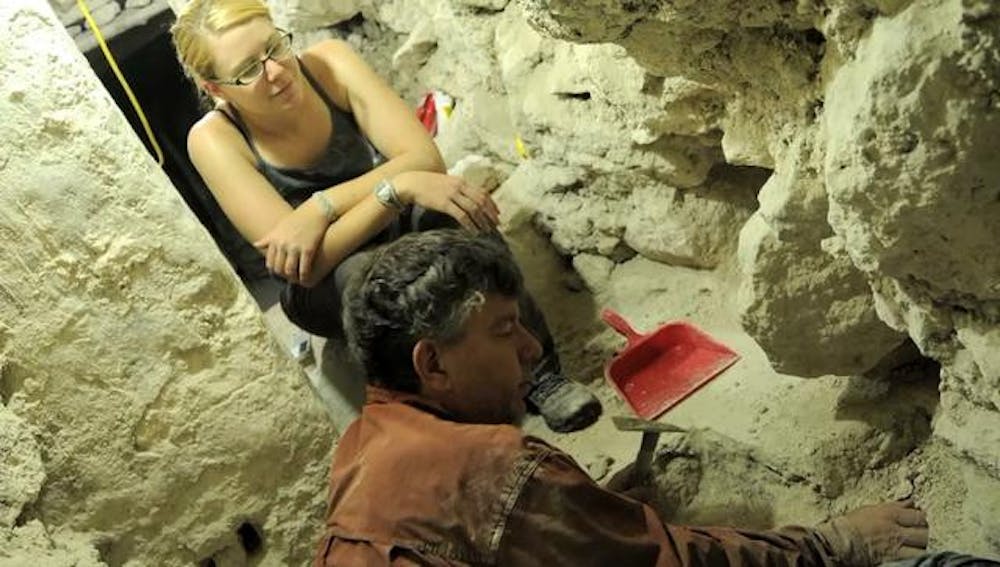In what he termed a "colossally important find," Professor of Anthropology Stephen Houston and his team of experts discovered the tomb of an ancient Maya king this summer. Located in Guatemala, the tomb enclosed the remains of the dead ruler, along with extraordinarily well-preserved examples of Maya pottery, paints and sculpture, as well as "cremated, butchered babies" and "human body parts in ceramic vessels," according to Houston.
"For us, it was a sinister kind of discovery," Houston said. Both within the tomb and in surrounding "caches," the team found vessels containing the remains of children.
Andrew Scherer, an assistant professor of anthropology who analyzed the human remains, said there were four children around the ages of one to two and two children around the ages of four to five. Their remains were found in vessels that appeared to have been lit on fire, charring the bodies of the children as a sacrifice for the recently deceased king. According to Scherer, this type of sacrifice for funeral purposes was only found in the case of kings or other very high-status individuals.
"A lot of misery went into the construction of the tomb," Houston said.
This find has provided researchers with important information about Maya civilization. Because of the tropical climate, wood carvings almost never survive to be examined by archaeologists. This discovery, however, included wooden artifacts that were preserved within the stone-and-mud-sealed tomb.
Although many of the samples were well-preserved by the tomb environment, Houston said that it appeared as if the king had been laid to rest on a scaffold which subsequently collapsed, smashing many of the objects.
Some items were in such fragile condition that the team called in a conservator, an expert skilled in preservation of ancient artifacts. Houston said he wanted to be careful that the team didn't engage in an "organized pillage," much like the looters of the '60s and '70s who stripped bare many ancient ruins.
The tomb also included pots that Houston called "museum quality" and that he expects will be on display in museums in Guatemala. He called the art "phenomenal."
"Everything was a royal commission, so it is the highest quality of the time," he said. The king was dressed as a dancer — the body had "clappers" made of dog or cat teeth on the arms and legs which would have let out "quite a racket," Houston said. Previously, these had been depicted in sculpture, but never seen.
They found examples of a trade pigment that was considered a precious substance because it sparkles in the sun. Houston said all the accumulated treasure was "like a tyrant going to the grave with heaps of Swiss gold."
The archaeologists also found an example of what Houston called "primordial bling." The king's teeth had jade and pyrite inlays so that when the king smiled, "you would see flashes of color and brilliance."
As Houston explained, learning about the city of El Zotz where the tomb was found would be like studying Poland — a state on the margins of very powerful historical players. Learning about these "shock zones" helps to clarify the history of the area around them, he said.
Morgan Ritter-Armour '11 spent July of this summer in Guatemala documenting the artifacts found in the tomb. Some artifacts need to be sketched because all the details aren't visible in photographs, Ritter-Armour wrote in an e-mail to The Herald. After learning "technical drawing techniques and some of the archeological techniques for drawing," she said, she worked with Rhode Island School of Design graduate Kallista Angeloff, drawing ceramic pottery pieces and figurines. These drawings will be retained as the artifacts are studied further.
But many of the artifacts only leave more questions. For Scherer, the infant remains lead to questions such as, "Why the young age? What does this tell us?" Houston said that upon opening the tomb he was "most exhilarated" but also "dismayed" because of the time and budget necessary for this important find. Scherer said the team cannot yet be sure about the significance of each discovery, but that "in light of the preservation and very controlled excavation … we will be looking at this deposit for years to come."

ADVERTISEMENT




